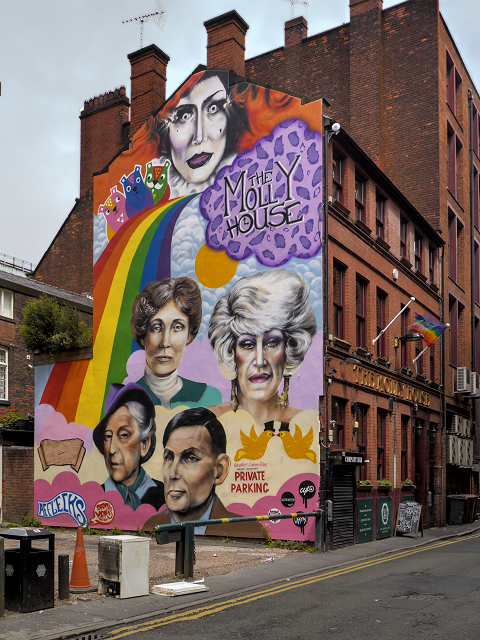SJ8497 : Richmond Street, The Molly House
taken 9 years ago, near to Manchester, England

In 18th century England, the term "molly" referred to an effeminate (usually homosexual) male Link
The enormous mural, which takes up the entire gable end of the building, was created in September 2014 to honour the city’s most famous gay people. It features five larger than life famous faces who are considered to be LGBT icons, two of which are very well known around Manchester’s gay scene; legendary drag queens Anna Phylactic (top) and Foo Foo Lammar (top right). The others are feminist Emmeline Pankhurst (top left), writer Quentin Crisp (bottom left) and computing pioneer Alan Turing (bottom right). The design, which also incorporates dancing bears on a rainbow, was chosen after a public competition organised by gay community group Queerchester. It features winning artist Glenn Jones' creation along with designs by runners up Lauren Jo Kelly, Adam Pryce and Mark Wallis (Link
See other images of Street Art in Manchester City Centre
Alan Mathison Turing was born in 1912. In 1935 he developed the concept of the Turing machine, considered to be the basis of the modern theory of computation. It was published in 1936, whilst he studied for a PhD.
During the Second World War Turing worked at Bletchley Park, the Government Code and Cypher School Headquarters, and his invention of the “Bombe” is credited with helping the Allied Forces win the war. Bombe was able to decode the previously “unbreakable” codes produced by the German Enigma machine, thus shortening the war and saving countless thousands of lives. In 1945 Turing was awarded the OBE by King George VI for his wartime services, but his work remained secret for many years.
After the war, Turing worked at the National Physical Laboratory, where he designed the ACE, among the first designs for a stored-program computer and in 1948 he joined Max Newman's Computing Machine Laboratory at the University of Manchester, where he helped develop the first digital computer “Baby”. He became part of the team responsible for most of the important breakthroughs in the development of the computer. He also worked on the subject of Artificial Intelligence.
In 1952 Turing disclosed his homosexuality to a detective investigating a burglary at his home. Homosexuality was at that time a criminal offence and he was arrested, and subsequently the man whose work had been crucial to the war effort was prosecuted in for homosexual acts and failed his security clearance at GCHQ, the post-war successor to Bletchley Park. He accepted treatment with DES (chemical castration) as an alternative to prison.
Turing died in 1954, 16 days before his 42nd birthday, from cyanide poisoning. Although the apple was never tested, an inquest determined his death as suicide, but it has been noted that the known evidence is equally consistent with accidental poisoning. In 2009, following an Internet campaign, then-Prime Minister Gordon Brown made a full and unequivocal official public apology on behalf of the British government for "the appalling way he was treated." Queen Elizabeth II granted him a posthumous pardon in 2013 Link(Daily Telegraph report).
LinkThe Alan Turing Home Page maintained by Andrew Hodges, author of “Alan Turing: the Enigma”
